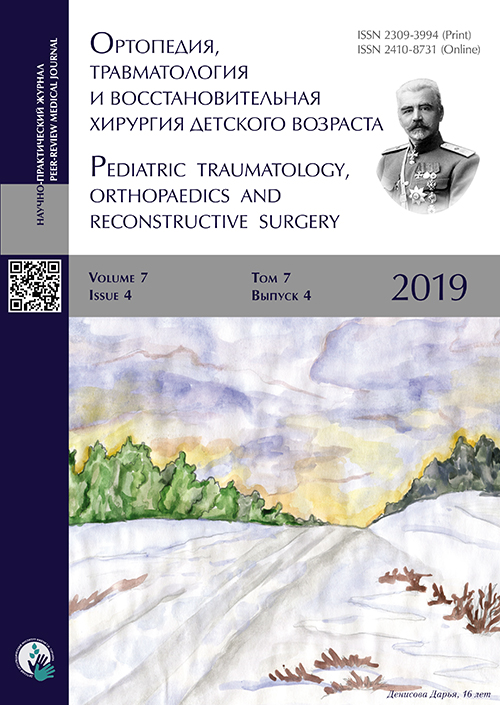Change in the severity of congenital clubfoot in the first week of life
- Authors: Kruglov I.Y.1, Rumyantsev N.Y.1, Omarov G.G.2, Rumiantceva N.N.1
-
Affiliations:
- Almazov National Medical Research Centre
- The Turner Scientific Research Institute for Children’s Orthopedics
- Issue: Vol 7, No 4 (2019)
- Pages: 49-56
- Section: Original Study Article
- URL: https://bakhtiniada.ru/turner/article/view/13000
- DOI: https://doi.org/10.17816/PTORS7449-56
- ID: 13000
Cite item
Abstract
Backgrоund. Congenital clubfoot or congenital equino-cava-varus deformity of the feet is one of the most common pathologies of the musculoskeletal system in children. Numerous articles in global literature have been published about changes in clubfoot severity during treatment; however, there are very few reports on how the severity of foot deformities with congenital clubfoot changes during the first week of life in the absence of deformity correction.
Aim. To analyze changes in the severity of congenital clubfoot in the first week of life without any treatment.
Materials and methods. The study group included 28 newborns with idiopathic congenital clubfoot (a total of 40 feet). The severity of clubfoot was evaluated on days one and seven after birth using the Dimeglio and Pirani scores.
Results. During the initial examination of the newborns on the first day of life, the clubfoot severity recorded on the Pirani score was between 2 to 3 points and between 9 to 15 points on the Dimeglio score. Thus, in the first seven days of life in all patients who did not receive treatment, there was a significant increase in the severity of the equino-cava-varus deformity of the feet (p < 0.05). The results of this study confirm that the severity of congenital clubfoot increases in the first week of life. This necessitates the beginning of the correction of severe idiopathic clubfoot in the first days after birth.
Conclusions. The severity of congenital clubfoot during the first week of life significantly increased in all feet studied (p < 0.05: χ2 higher than in the table). If left untreated in the first week after birth, the equinus deformity progresses followed by varus deformity, anterior forefoot reduction, and, to a lesser extent, rotation.
Full Text
##article.viewOnOriginalSite##About the authors
Igor Yu. Kruglov
Almazov National Medical Research Centre
Author for correspondence.
Email: dr.gkruglov@gmail.com
ORCID iD: 0000-0003-1234-1390
SPIN-code: 7777-1047
MD, Paediatric Orthopaedic Surgeon, Junior Researcher of Research Laboratory of Congenital and Hereditary Pathology Surgery
Russian Federation, 2 Akkuratova str., Saint- Petersburg, 197341Nicolai Yu. Rumyantsev
Almazov National Medical Research Centre
Email: dr.rumyantsev@gmail.com
ORCID iD: 0000-0002-4956-6211
MD, Paediatric Orthopaedic Surgeon
Russian Federation, 2 Akkuratova str., Saint- Petersburg, 197341Gamzat G. Omarov
The Turner Scientific Research Institute for Children’s Orthopedics
Email: ortobaby@yandex.ru
ORCID iD: 0000-0002-9252-8130
MD, PhD, Senior Research Associate
Russian Federation, 64, Parkovaya str., Saint-Petersburg, Pushkin, 196603Natalia N. Rumiantceva
Almazov National Medical Research Centre
Email: natachazlaya@mail.ru
ORCID iD: 0000-0002-2052-451X
MD, Paediatric Orthopaedic Surgeon, Junior Researcher of Research Laboratory of Congenital and Hereditary Pathology Surgery
Russian Federation, 2 Akkuratova str., Saint- Petersburg, 197341References
- Dobbs MB, Nunley R, Schoenecker PL. Long-term follow-up of patients with clubfeet treated with extensive soft-tissue release. J Bone Joint Surg Am. 2006;88(5):986-996. https://doi.org/10.2106/JBJS.E.00114.
- Pirani S, Outerbridge HK, Sawatzky B, Stothers K. A relianle method of clinically evaluating a virgin clubfoot evaluation. In: 21st SICOT Congress. Vol. 29. Sydney; 1999. P. 2-30.
- Dimeglio A, Bensahel H, Souchet P, et al. Classification of clubfoot. J Pediatr Orthop B. 1995;4(2):129-136. https://doi.org/10.1097/01202412-199504020-00002.
- Erickson M, Caprio B. Deformities of the extremities. In: Hat WW, Levin MJ, Deterding RR, Abzug MJ. Current diagnosis and treatment pediatrics. 22nd ed. New York: McGraw Hill; 2014. P. 863-865.
- Ponseti IV. Congenital Clubfoot. Fundamentals of treatment. New York: Oxford University Press; 1996.
- Hosalkar HH, Spiegel DA, Davidson RS. Talipes equinovarus (clubfoot). In: Kliegman RM, Stanton BF, St. Geme III JW, et al. Nelson Textbook of Pediatrics. 19th ed. Philadelphia: Elsevier; 2011. P. 2336-2337. (In Russ.)
- Mosca VS. The foot. In: Lovell and Winter’s Pediatric Orthopedics. Vol. 2. 7th ed. Ed. by S.L. Weinstein, J.M. Flynn. Philadelphia: Lippincott Williams & Wilkins; 2013. P. 1388-1525.
- Sharma A, Shukla S, Kiran B, et al. Can the Pirani score predict the number of casts and the need for tenotomy in the management of clubfoot by the Ponseti method? Malays Orthop J. 2018;12(1):26-30. https://doi.org/10.5704/MOJ.1803.005.
- Ramirez N, Flynn JM, Fernandez S, et al. Orthosis noncompliance after the Ponseti method for the treatment of idiopathic clubfeet: a relevant problem that needs reevaluation. J Pediatr Orthop. 2011;31(6):710-715. https://doi.org/10.1097/BPO.0b013e318221eaa1.
- Bor N, Coplan JA, Herzenberg JE. Ponseti treatment for idiopathic clubfoot: minimum 5-year followup. Clin Orthop Relat Res. 2009;467(5):1263-1270. https://doi.org/10.1007/s11999-008-0683-8.
- Iltar S, Uysal M, Alemdaroglu KB, et al. Treatment of clubfoot with the Ponseti method: should we begin casting in the newborn period or later? J Foot Ankle Surg. 2010;49(5):426-431. https://doi.org/10.1053/j.jfas.2010.06.010.
Supplementary files











